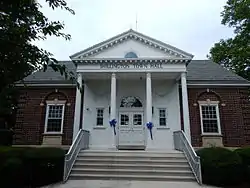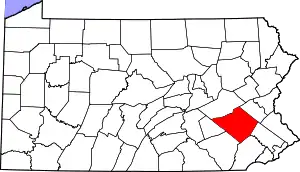Shillington, Pennsylvania
Shillington is a borough in Berks County, Pennsylvania, United States with a population of 5,273 at the 2010 census[3] nestled amongst other suburbs outside Reading. It is perhaps best known for being the location of the homestead to Pennsylvania's first governor, Thomas Mifflin,[4] and as the childhood home of American author John Updike. Many of Updike's stories take place in the fictional town of Olinger, a lightly-disguised version of Shillington, and in its environs.
Shillington, Pennsylvania | |
|---|---|
 Shillington Town Hall | |
| Nickname(s): "The Town Beautiful" | |
 Location in Berks County, Pennsylvania | |
 Shillington Location in Pennsylvania  Shillington Location in the United States | |
| Coordinates: 40°18′16″N 75°58′01″W | |
| Country | United States |
| State | Pennsylvania |
| County | Berks |
| Area | |
| • Total | 1.00 sq mi (2.60 km2) |
| • Land | 1.00 sq mi (2.59 km2) |
| • Water | 0.01 sq mi (0.01 km2) |
| Elevation | 354 ft (108 m) |
| Population (2010) | |
| • Total | 5,273 |
| • Estimate (2019)[2] | 5,319 |
| • Density | 5,324.32/sq mi (2,055.27/km2) |
| Time zone | UTC-5 (EST) |
| • Summer (DST) | UTC-4 (EDT) |
| ZIP Code | 19607 |
| Area code(s) | 610 and 484 |
| FIPS code | 42-70248 |
| Website | www |
History
Shillington began in 1860 as part of Cumru Township, when local landowner and borough namesake Samuel Shilling sold some of his lots for residences. The area had an inn, originally built in 1762, called the Three Mile House because it was 3 miles (5 km) from Reading on the Lancaster Pike. The inn was a popular stop for farmers going to the city's markets, and later it sat near a horse racing track built by Aaron Einstein in 1868. A post office opened in Shillington in 1884. On August 18, 1908, the Quarter Session Court officially incorporated the borough of Shillington as a separate municipality from Cumru Township with a population of 450.[5] Later that year Shillington elected its first official, Adam Rollman, as chief burgess. Borough council meetings were held in various locations over the years until the present town hall was completed in 1932.[5]
Much of the borough's present land was occupied by Angelica Farm which would be established as an almshouse, or poorhouse, in 1824. The alms house was replaced by Bern Township's Berks Heim in 1952. The buildings of the Governor Mifflin School District now occupy most of land that was once part of the almshouse. Today, the most notable visible remnant of the poorhouse is a stone wall that is within short walking distance down the road from John Updike's old home. Updike's first novel, The Poorhouse Fair, is set in a fictional building based on Shillington's poorhouse. Many of Updike's earliest stories were set in the fictional version of Shillington named Olinger, and some of them were collected in the volume Olinger Stories.
[6][7] Angelica Farm was also the historical home of Thomas Mifflin, the first governor of Pennsylvania and 11th President of the Continental Congress.
Education
Shillington borough is home to the Governor Mifflin School District. Within Shillington Borough there are 2 schools: Governor Mifflin Senior High School and the Governor Mifflin Middle School. GMSD also has other elementary schools in Cumru Township and Brecknock Township.
Notable people
- Kenny Brightbill, Race Car Driver, Nicknamed the "Shillington Slingshot"
- Chip Kidd, book designer
- Thomas Mifflin, first governor of Pennsylvania
- John Updike, author
Geography
Shillington is located at 40°18′16″N 75°58′1″W (40.304342, -75.966855).[8] It is situated in southeastern Pennsylvania, adjacent to Reading, the county seat, and about 60 miles (97 km) northwest of Philadelphia. Wyomissing Creek, a tributary of the Schuylkill River, runs along the western border of Shillington. Cumru Township largely surrounds Shillington, except for the border with Wyomissing in the northwest.
According to the United States Census Bureau, the borough has a total area of 0.97 square miles (2.5 km2), of which 0.004 square miles (0.01 km2), or 0.57%, is water.[3]
Demographics
| Historical population | |||
|---|---|---|---|
| Census | Pop. | %± | |
| 1880 | 136 | — | |
| 1910 | 1,427 | — | |
| 1920 | 2,175 | 52.4% | |
| 1930 | 4,401 | 102.3% | |
| 1940 | 4,932 | 12.1% | |
| 1950 | 5,059 | 2.6% | |
| 1960 | 5,639 | 11.5% | |
| 1970 | 6,249 | 10.8% | |
| 1980 | 5,601 | −10.4% | |
| 1990 | 5,062 | −9.6% | |
| 2000 | 5,059 | −0.1% | |
| 2010 | 5,273 | 4.2% | |
| 2019 (est.) | 5,319 | [2] | 0.9% |
| Sources:[9][10][11] | |||
As of the census[10] of 2000, there were 5,059 people, 2,238 households, and 1,405 families residing in the borough. The population density was 4,964.4 people per square mile (1,915.0/km2). There were 2,321 housing units at an average density of 2,277.6 per square mile (878.6/km2). The racial makeup of the borough was 97.11% White, 0.49% African American, 0.10% Native American, 0.53% Asian, 0.75% from other races, and 1.01% from two or more races. Hispanic or Latino of any race were 2.10% of the population.
There were 2,238 households, out of which 26.5% had children under the age of 18 living with them, 50.0% were married couples living together, 9.6% had a female householder with no husband present, and 37.2% were non-families. 31.7% of all households were made up of individuals, and 14.4% had someone living alone who was 65 years of age or older. The average household size was 2.26 and the average family size was 2.84.
In the borough the population was spread out, with 21.5% under the age of 18, 6.6% from 18 to 24, 29.3% from 25 to 44, 21.1% from 45 to 64, and 21.5% who were 65 years of age or older. The median age was 40 years. For every 100 females there were 89.8 males. For every 100 females age 18 and over, there were 84.4 males.
The median income for a household in the borough was $43,833, and the median income for a family was $52,500. Males had a median income of $35,318 versus $27,179 for females. The per capita income for the borough was $22,322. About 2.2% of families and 3.7% of the population were below the poverty line, including 2.4% of those under age 18 and 5.3% of those age 65 or over.
Gallery
 Corner of Philadelphia and Lancaster Avenues. War Memorial.
Corner of Philadelphia and Lancaster Avenues. War Memorial. St. Luke's Evangelical Church
St. Luke's Evangelical Church W. Lancaster Ave.
W. Lancaster Ave. Mifflin Community Library
Mifflin Community Library
References
- "2019 U.S. Gazetteer Files". United States Census Bureau. Retrieved July 28, 2020.
- "Population and Housing Unit Estimates". United States Census Bureau. May 24, 2020. Retrieved May 27, 2020.
- "Geographic Identifiers: 2010 Demographic Profile Data (G001): Shillington borough, Pennsylvania". U.S. Census Bureau, American Factfinder. Archived from the original on February 12, 2020. Retrieved March 10, 2014.
- "A Biography of Thomas Mifflin 1744-1800 < Biographies < American History From Revolution To Reconstruction and beyond". www.let.rug.nl. Retrieved 2017-03-11.
- "Shillington Borough History". Borough of Shillington. Retrieved 2008-03-30.
- "Pennsylvania Poorhouse History by county: Berks". The Poorhouse Story. Retrieved 2009-10-04.
- John Updike (January 1985). "Fictional Houses". Architectural Digest. Retrieved 2009-10-04.
in my first novel, The Poorhouse Fair, I set characters roaming the corridors of an immense imaginary mansion I had based upon an institutional building for the poor and homeless, which had stood at the end of the street where my family had lived in Pennsylvania
- "US Gazetteer files: 2010, 2000, and 1990". United States Census Bureau. 2011-02-12. Retrieved 2011-04-23.
- "Census of Population and Housing". U.S. Census Bureau. Retrieved 11 December 2013.
- "U.S. Census website". United States Census Bureau. Retrieved 2008-01-31.
- "Incorporated Places and Minor Civil Divisions Datasets: Subcounty Resident Population Estimates: April 1, 2010 to July 1, 2012". Population Estimates. U.S. Census Bureau. Archived from the original on 17 June 2013. Retrieved 11 December 2013.
- Shillington Borough (PDF). Published by the Reading Eagle on August 5, 2002.
External links
- Borough of Shillington official website
- WEEU Community Salutes: Shillington, includes pictures
- AllRefer Gazetteer: Shillington
| Wikimedia Commons has media related to Shillington, Pennsylvania. |
